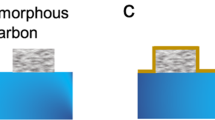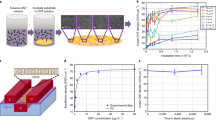Abstract
The prevailing conception of carbon nanotubes and particularly single-walled carbon nanotubes (SWNTs) continues to be one of perfectly crystalline wires. Here, we demonstrate a selective electrochemical method that labels point defects and makes them easily visible for quantitative analysis. High-quality SWNTs are confirmed to contain one defect per 4 μm on average, with a distribution weighted towards areas of SWNT curvature. Although this defect density compares favourably to high-quality, silicon single-crystals, the presence of a single defect can have tremendous electronic effects in one-dimensional conductors such as SWNTs. We demonstrate a one-to-one correspondence between chemically active point defects and sites of local electronic sensitivity in SWNT circuits, confirming the expectation that individual defects may be critical to understanding and controlling variability, noise and chemical sensitivity in SWNT electronic devices. By varying the SWNT synthesis technique, we further show that the defect spacing can be varied over orders of magnitude. The ability to detect and analyse point defects, especially at very low concentrations, indicates the promise of this technique for quantitative process analysis, especially in nanoelectronics development.
This is a preview of subscription content, access via your institution
Access options
Subscribe to this journal
Receive 12 print issues and online access
$259.00 per year
only $21.58 per issue
Buy this article
- Purchase on Springer Link
- Instant access to full article PDF
Prices may be subject to local taxes which are calculated during checkout




Similar content being viewed by others
References
Ebbesen, T. W. & Takada, T. Topological and sp3 defect structures in nanotubes. Carbon 33, 973–978 (1995).
Thess, A. et al. Crystalline ropes of metallic carbon nanotubes. Science 273, 483–487 (1996).
Cassell, A. M., Raymakers, J. A., Kong, J. & Dai, H. J. Large scale CVD synthesis of single-walled carbon nanotubes. J. Phys. Chem. B 103, 6484–6492 (1999).
Kong, J., Soh, H. T., Cassell, A. M., Quate, C. F. & Dai, H. J. Synthesis of individual single-walled carbon nanotubes on patterned silicon wafers. Nature 395, 878–881 (1998).
Nikolaev, P. et al. Gas-phase catalytic growth of single-walled carbon nanotubes from carbon monoxide. Chem. Phys. Lett. 313, 91–97 (1999).
Hata, K. et al. Water-assisted highly efficient synthesis of impurity-free single-walled carbon nanotubes. Science 306, 1362–1364 (2004).
Bom, D. et al. Thermogravimetric analysis of the oxidation of multiwalled carbon nanotubes: Evidence for the role of defect sites in carbon nanotube chemistry. Nano Lett. 2, 615–619 (2002).
Hamon, M. A. et al. End-group and defect analysis of soluble single-walled carbon nanotubes. Chem. Phys. Lett. 347, 8–12 (2001).
Dillon, A. C. et al. Systematic inclusion of defects in pure carbon single-wall nanotubes and their effect on the Raman D-band. Chem. Phys. Lett. 401, 522–528 (2005).
Clauss, W. et al. Electron backscattering on single-wall carbon nanotubes observed by scanning tunneling microscopy. Europhys. Lett. 47, 601–607 (1999).
Kim, H. et al. Direct observation of localized defect states in semiconductor nanotube junctions. Phys. Rev. Lett. 90, 216107 (2003).
Ishigami, M. et al. Identifying defects in nanoscale materials. Phys. Rev. Lett. 93, 196803 (2004).
Doorn, S. K. et al. Raman spectroscopy and imaging of ultralong carbon nanotubes. J. Phys. Chem. B 109, 3751–3758 (2005).
Louie, S. G. in Carbon Nanotubes 113–145 (Springer, Berlin, 2001).
Zach, M. P., Ng, K. H. & Penner, R. M. Molybdenum nanowires by electrodeposition. Science 290, 2120–2123 (2000).
Penner, R. M. Mesoscopic metal particles and wires by electrodeposition. J. Phys. Chem. B 106, 3339–3353 (2002).
Walter, E. C. et al. Metal nanowire arrays by electrodeposition. Chem. Phys. Chem. 4, 131–138 (2003).
Banks, C. E., Davies, T. J., Wildgoose, G. G. & Compton, R. G. Electrocatalysis at graphite and carbon nanotube modified electrodes: edge-plane sites and tube ends are the reactive sites. Chem. Commun. 829–841 (2005).
An, L., Owens, J. M., McNeil, L. E. & Liu, J. Synthesis of nearly uniform single-walled carbon nanotubes using identical metal-containing molecular nanoclusters as catalysts. J. Am. Chem. Soc. 124, 13688–13689 (2002).
Kruger, M., Buitelaar, M. R., Nussbaumer, T., Schonenberger, C. & Forro, L. Electrochemical carbon nanotube field-effect transistor. Appl. Phys. Lett. 78, 1291–1293 (2001).
Chen, J. et al. Solution properties of single-walled carbon nanotubes. Science 282, 95–98 (1998).
Braun, E., Eichen, Y., Sivan, U. & Ben-Yoseph, G. DNA-templated assembly and electrode attachment of a conducting silver wire. Nature 391, 775–778 (1998).
Heller, I. et al. Individual single-walled carbon nanotubes as nanoelectrodes for electrochemistry. Nano Lett. 5, 137–142 (2005).
Kissinger, G., Gräf, D., Lambert, U., Grabolla, T. & Richter, H. Key influence of the thermal history on process-induced defects in Czochralski silicon wafers. Semicond. Sci. Technol. 12, 933–937 (1997).
Xi, Z., Chen, J., Yang, D., Lawerenz, A. & Moeller, H. J. Copper precipitation in large-diameter Czochralski silicon. J. Appl. Phys. 97, 094909 (2005).
Dresselhaus, M. S. et al. Science and applications of single-nanotube Raman spectroscopy. J. Nanosci. Nanotechnol. 3, 19–37 (2003).
Pimenta, M. A. et al. Diameter dependence of the Raman D-band in isolated single-wall carbon nanotubes. Phys. Rev. B 64, 041401 (2001).
Mann, D., Javey, A., Kong, J., Wang, Q. & Dai, H. J. Ballistic transport in metallic nanotubes with reliable Pd ohmic contacts. Nano Lett. 3, 1541–1544 (2003).
Bradley, K., Gabriel, J. C. P. & Gruner, G. Flexible nanotube electronics. Nano Lett. 3, 1353–1355 (2003).
Li, S. D., Yu, Z., Rutherglen, C. & Burke, P. J. Electrical properties of 0.4 cm long single-walled carbon nanotubes. Nano Lett. 4, 2003–2007 (2004).
Yao, Z., Dekker, C. & Avouris, P. in Carbon Nanotubes 147–171 (Springer, Berlin, 2001).
Heinze, S. et al. Carbon nanotubes as Schottky barrier transistors. Phys. Rev. Lett. 89, 106801 (2002).
Bockrath, M. et al. Resonant electron scattering by defects in single-walled carbon nanotubes. Science 291, 283–285 (2001).
Bachtold, A. et al. Scanned probe microscopy of electronic transport in carbon nanotubes. Phys. Rev. Lett. 84, 6082–6085 (2000).
Tans, S. J. & Dekker, C. Molecular transistors — potential modulations along carbon nanotubes. Nature 404, 834–835 (2000).
Freitag, M., Johnson, A. T., Kalinin, S. V. & Bonnell, D. A. Role of single defects in electronic transport through carbon nanotube field-effect transistors. Phys. Rev. Lett. 89, 216801 (2002).
Banerjee, S., Hemraj-Benny, T. & Wong, S. S. Covalent surface chemistry of single-walled carbon nanotubes. Adv. Mater. 17, 17–29 (2005).
Duesberg, G. S. et al. Experimental observation of individual single-wall nanotube species by Raman microscopy. Chem. Phys. Lett. 310, 8–14 (1999).
Acknowledgements
We thank Nanomix, R. Haddon, and P. Burke for supplying various types of SWNT for this study, N. Emmott for experimental assistance and R. Penner for sharing his expertise with HOPG. Partially funded by NSF 0404057 and the ACS PRF-39672-G5M.
Author information
Authors and Affiliations
Corresponding author
Ethics declarations
Competing interests
The authors declare no competing financial interests.
Rights and permissions
About this article
Cite this article
Fan, Y., Goldsmith, B. & Collins, P. Identifying and counting point defects in carbon nanotubes. Nature Mater 4, 906–911 (2005). https://doi.org/10.1038/nmat1516
Received:
Accepted:
Published:
Issue Date:
DOI: https://doi.org/10.1038/nmat1516
This article is cited by
-
Selective and self-validating breath-level detection of hydrogen sulfide in humid air by gold nanoparticle-functionalized nanotube arrays
Nano Research (2022)
-
Controlling the optical properties of carbon nanotubes with organic colour-centre quantum defects
Nature Reviews Chemistry (2019)
-
Computational study on thermal conductivity of defective carbon nanomaterials: carbon nanotubes versus graphene nanoribbons
Journal of Materials Science (2018)
-
Variations in biocorona formation related to defects in the structure of single walled carbon nanotubes and the hyperlipidemic disease state
Scientific Reports (2017)
-
Elastic properties of nanocomposite materials: influence of carbon nanotube imperfections and interface bonding
Meccanica (2017)



